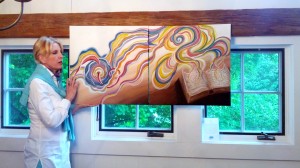Recently, my friend and fellow creator Julie Lavender released her music CD The Siddur Project.
Julie hosts the syndicated Dreamfarm Café radio show, which features area musicians: an “experience of eclectic jazz,” says the show’s website, “an intimate window into the very heart of an artist’s creative process.”
But Julie also writes and performs her own original music, and paints original art as well. Hence, The Siddur Project.
The Siddur Project is actually not just a CD, but also a set of artwork, all inspired by the Jewish prayerbook (called a siddur). Stylistically, the music is what I would call “PBS jazz” fused with world folk. Content-wise, the lyrics artfully embrace the Messianic Jewish liturgy.
Above, Julie poses with the cover art piece, called “Modim,” in her home studio. This piece is inspired by a Jewish blessing often known as Hoda’ah, literally “thanksgiving,” the next-to-last blessing of the Amidah, which is the centerpiece of the Jewish liturgy.
We thank you that you are The Lord, our God and God of our ancestors for all eternity. Rock of our lives, shield of our salvation you are, in every generation. We thank you and recount your praise, for our lives which are entrusted to your care, for our souls which are in your charge, for your miracles which are daily with us, for your continual wonders and goodness, in every season, evening, morning, and noon. O Beneficent One, your mercy is never exhausted. O Compassionate One, your steadfast love is never-ending. We have always put our hope in you.
And for all of these things, may your name be blessed and exalted, our ruler, always, forevermore.
May every living being thank you and praise your name truthfully, the God of our deliverance and our help. Selah. Blessed are you, Lord; your name is Goodness, and to you it is fitting to give thanks.
It is a matter of some interpretation and debate whether Julie’s painting “Modim” represents our thanks rising to God, or God’s touch descending on us as we thank him.
The Siddur Project music and artwork are available from The Siddur Project website. The physical CD liner notes include lyrics and commentary, as well as photos of the artwork.
Lastly, here’s a snippet of one of my favorite tracks from the album, “Mah Tovu,” a call to worship.
-TimK

Does Julie’s painting “Modim†represent our thanks rising to God, or God’s touch descending on us as we thank him?
Grace recommends that when we touch God, God actually touched us first. G R A C E =” God’s Reach at Calvary Extended.
However, Jewish theology correctly observes our part in recognizing God’s hand and our reaching up to grasp hold. (Faith)